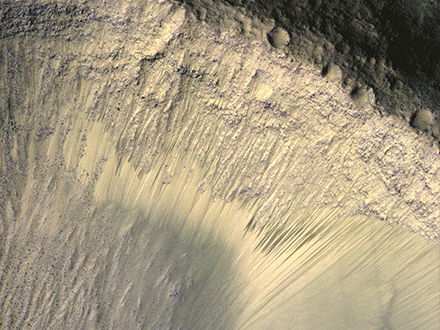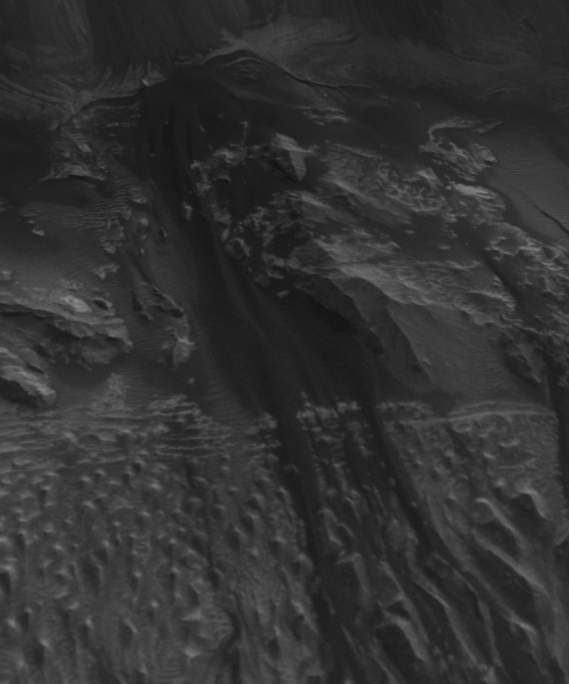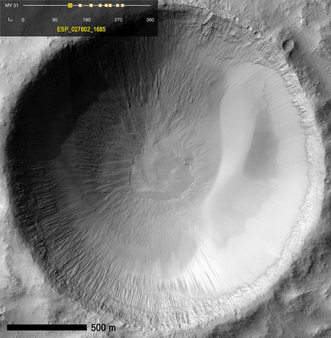It looks like you're using an Ad Blocker.
Please white-list or disable AboveTopSecret.com in your ad-blocking tool.
Thank you.
Some features of ATS will be disabled while you continue to use an ad-blocker.
share:
NASA Mars spacecraft reveals a more dynamic
Red Planet
Very exciting!
We are not talking about evidence of ancient salty water, but the possibility of salty water present on Mars today causing seasonal changes that the MRO was able to see from orbit!
NASA's Mars Reconnaissance Orbiter has revealed to scientists slender dark markings -- possibly due to salty water – that advance seasonally down slopes surprisingly close to the Martian equator.
"The equatorial surface region of Mars has been regarded as dry, free of liquid or frozen water, but we may need to rethink that," said Alfred McEwen of the University of Arizona in Tucson, principal investigator for the Mars Reconnaissance Orbiter (MRO) High Resolution Imaging Science Experiment (HiRISE) camera.
Very exciting!
We are not talking about evidence of ancient salty water, but the possibility of salty water present on Mars today causing seasonal changes that the MRO was able to see from orbit!
Does water
still flow across Mars? Dark, mysterious tracks hold clues
Here is a better written article about the discovery.
'
Perhaps the Red Planet’s dry equatorial region is still a little wetter than we thought. NASA's Mars Reconnaissance Orbiter has discovered strange dark lines that vanish and reappear with the seasons, and scientists think they could be signs of salty water that may intermittently flow near the surface of Mars.
These recurring thin lines are typically less than 16 feet wide and can stretch for three quarters of a mile. They fade in cooler times and reappear in warmer ones – perhaps because in the warmer seasons or in direct sunlight the water would evaporate, leaving the salt marks behind. (Think of the sweat stains in clothing – those dark rings are the salt and minerals left from your sweat after the water has evaporated.)
Here is a better written article about the discovery.
Well that's cool!
I almost feel bad for making fun of the Mars rat threads, almost. Ok, that's just lie, but anything is possible I guess.
I almost feel bad for making fun of the Mars rat threads, almost. Ok, that's just lie, but anything is possible I guess.
zilebeliveunknown
Ha! I told so...
www.abovetopsecret.com...
I bet next time they will announce that they found evidence of salt water, following the discovery with evidence of seas on Mars and eventually oceans
Oh, and rain, hail, snow, fog and all agregate conditions of water
You hit the nail on the head!
Here is a better picture of the features they are referring to:


BomSquad
Here is a better picture of the features they are referring to:
Stupid question time!
Is there a chance the dark markings in that crater are shadows as the sun moves round ? Or different colo(u)r dust getting blown by Mars wind ?
I don't know the answer lol sorry
reply to post by ThePeaceMaker
If these were merely shadows, I think there would be additional long streaks from other high points around and in the crater. Those do not appear to be in evidence.
If these were merely shadows, I think there would be additional long streaks from other high points around and in the crater. Those do not appear to be in evidence.
reply to post by BomSquad
Cheers Bom I'm no expert in this field was just throwing out a silly question
Cheers Bom I'm no expert in this field was just throwing out a silly question
BomSquad
Here is a better picture of the features they are referring to:
That could be liquid, or it could be landslides of fine silty soil.
edit on 12/11/2013 by Soylent Green Is People because: (no reason given)
reply to post by Soylent Green Is People
It could, but the changes appear to be seasonal in nature. Seasonal landsides, while not impossible, would be an unlikely explanation, in my opinion.
It could, but the changes appear to be seasonal in nature. Seasonal landsides, while not impossible, would be an unlikely explanation, in my opinion.
Puzzling Streaks On Mars May Be From Flowing Water
Another good article regarding this new discovery.
Dark seasonal streaks on slopes near the Martian equator may be a sign of flowing salt water on Mars, liquid runoff that melts and evaporates during the planet's warmer months, scientists say.
NASA's Mars Reconnaissance Orbiter spotted the dark streaks on Mars as they formed and grew in the planet's late spring and summer seasons, when the Martian equatorial region receives the most sunlight. The streaks then faded the next season as cooler temperatures prevailed.
Another good article regarding this new discovery.
BomSquad
reply to post by Soylent Green Is People
It could, but the changes appear to be seasonal in nature. Seasonal landsides, while not impossible, would be an unlikely explanation, in my opinion.
Have they been observing this long enough to go through TWO cycles of seasons -- i.e., did they see it happen twice (once each during the same season two Mars years in a row)? That might indicate seasonality. I know the article mentions it happens when the sun strikes the slopes, but they did not specify if it happened seasonally at least twice (in two or more successive seasons) along THE SAME slopes.
I suppose the dark streaks could be a little bit of both water and silt. Many Mars researchers feel that there could be liquid ground water beneath the surface of Mars, and perhaps what we are seeing is a muddy flow.
The mud in the water would prevent it from sublimating/evaporating away right away, as plain water would do in the extremely low air pressures of Mars.
edit on 12/11/2013 by Soylent Green Is People because: (no reason given)
reply to post by Soylent Green Is People
I see your point. One article I read did state that the observations were made over 2 years..but they didn't specify whether it was 2 Earth years or 2 Mars years. It would make a difference since a single Mars years is nearly 2 Earth years long.
I see your point. One article I read did state that the observations were made over 2 years..but they didn't specify whether it was 2 Earth years or 2 Mars years. It would make a difference since a single Mars years is nearly 2 Earth years long.
Here is another article that just came out on this:
Nature: Water seems to flow freely on Mars
Apparently they have found the streaks in a lot more places now, and that's why the new announcement came out. The Nature article includes a video of stills that are a lot more zoomed in and seem to show tracks created by water flowing. It's not a YouTube video, so I couldn't embed it, but you can see it at the link above.
Nature: Water seems to flow freely on Mars
Apparently they have found the streaks in a lot more places now, and that's why the new announcement came out. The Nature article includes a video of stills that are a lot more zoomed in and seem to show tracks created by water flowing. It's not a YouTube video, so I couldn't embed it, but you can see it at the link above.
I find it a little..uhm..disappointing that we (Russians and USA) send up probes and missions to Mars SINCE THE 60s...and still all what we have is a
"possible evidence" and not even conclusive proof whether life exists/existed or something essential as water.
So..after 50 years of missions...we STILL don't even know whether water flows on Mars? How many probes and landers do we have to send up (STILL) until we can get the basics, without having to use the word "possible"....
So..after 50 years of missions...we STILL don't even know whether water flows on Mars? How many probes and landers do we have to send up (STILL) until we can get the basics, without having to use the word "possible"....
edit on 32013R000000WednesdayAmerica/Chicago49PMWednesdayWednesday by
NoRulesAllowed because: (no reason given)
reply to post by NoRulesAllowed
Scientists will always qualify their statements with "possible" until they have incontrovertible proof. That's just the way it is....
I'm surprised there isn't more interest in this discovery...things are pretty quiet.
Scientists will always qualify their statements with "possible" until they have incontrovertible proof. That's just the way it is....
I'm surprised there isn't more interest in this discovery...things are pretty quiet.
I'm still doubtful and think it's just dark sand trickling down. Sand flowing downslope can behave like a liquid.
Here's a similar occurence, in Mars' Hebes Chasma:

Looks like some dark liquid trickling down and pooling at the bottom, but closer inspection reveals that it's sand.

I'd wait for closer images and spectroscopic analysis before I can confidently accept the possibility that it's salty water.
Here's a similar occurence, in Mars' Hebes Chasma:

Looks like some dark liquid trickling down and pooling at the bottom, but closer inspection reveals that it's sand.

I'd wait for closer images and spectroscopic analysis before I can confidently accept the possibility that it's salty water.
zilebeliveunknown
Ha! I told so...
www.abovetopsecret.com...
No, you said ...
I bet next time they will announce that they found evidence of salt water, following the discovery with evidence of seas on Mars and eventually oceans %
Oh, and rain, hail, snow, fog and all agregate conditions of water.
You were incorrect. And if you think this discovery supports that then you have no understanding of this discovery. It's basically mud tracks made by extremely salty water that is melting at certain times of the year. No pools or puddles, no oceans.
reply to post by OccamsRazor04
I said:
NASA found evidence of salt water. Right?
Where do you see I was being wrong?
And the rest of my statement was more in a sarcastic manner, since NASA has been parroting about water on Mars for quite some time. But that doesn't necessarilly means there isn't liquid water on Mars, it's just they didn't found it yet. Liquid water has evaporated from the SURFACE, BUT what lies BENEATH we still don't know.
ETA: Oh, salty water flows on the surface of Mars
Water Flowing on Mars
Yes, it's seasonal, but it FLOWS!!!
I said:
I bet next time they will announce that they found evidence of salt water
NASA found evidence of salt water. Right?
Where do you see I was being wrong?
And the rest of my statement was more in a sarcastic manner, since NASA has been parroting about water on Mars for quite some time. But that doesn't necessarilly means there isn't liquid water on Mars, it's just they didn't found it yet. Liquid water has evaporated from the SURFACE, BUT what lies BENEATH we still don't know.
ETA: Oh, salty water flows on the surface of Mars
Water Flowing on Mars
Yes, it's seasonal, but it FLOWS!!!
edit on 12-12-2013 by zilebeliveunknown because: (no reason given)
new topics
-
It's Offical Now
US Political Madness: 8 minutes ago -
The reason it works is.....
General Chit Chat: 53 minutes ago -
Dick Van Dyke saved from Wildfire by neighbours on his 99th birthday
People: 3 hours ago
top topics
-
1 Billion dollars
General Entertainment: 17 hours ago, 6 flags -
Dick Van Dyke saved from Wildfire by neighbours on his 99th birthday
People: 3 hours ago, 2 flags -
The reason it works is.....
General Chit Chat: 53 minutes ago, 1 flags -
It's Offical Now
US Political Madness: 8 minutes ago, 0 flags
active topics
-
Trump says ownership of Greenland 'is an absolute necessity'
Other Current Events • 47 • : Xtrozero -
London Christmas Market BANS Word ‘Christmas’
Social Issues and Civil Unrest • 38 • : GENERAL EYES -
It's Offical Now
US Political Madness • 0 • : BernnieJGato -
NYPD arrests migrant who allegedly set woman on fire on subway train, watched her burn to death
Breaking Alternative News • 53 • : GENERAL EYES -
-@TH3WH17ERABB17- -Q- ---TIME TO SHOW THE WORLD--- -Part- --44--
Dissecting Disinformation • 3809 • : Crazierfox -
The reason it works is.....
General Chit Chat • 0 • : DAVID64 -
Christmas Dinner ??
Food and Cooking • 16 • : Naftalin -
Dick Van Dyke saved from Wildfire by neighbours on his 99th birthday
People • 0 • : gortex -
RIP Merrily Harpur British Big Cat Realist
Cryptozoology • 4 • : TimBurr -
Statements of Intent from Incoming Trump Administration Members - 2025 to 2029.
2024 Elections • 51 • : WeMustCare


